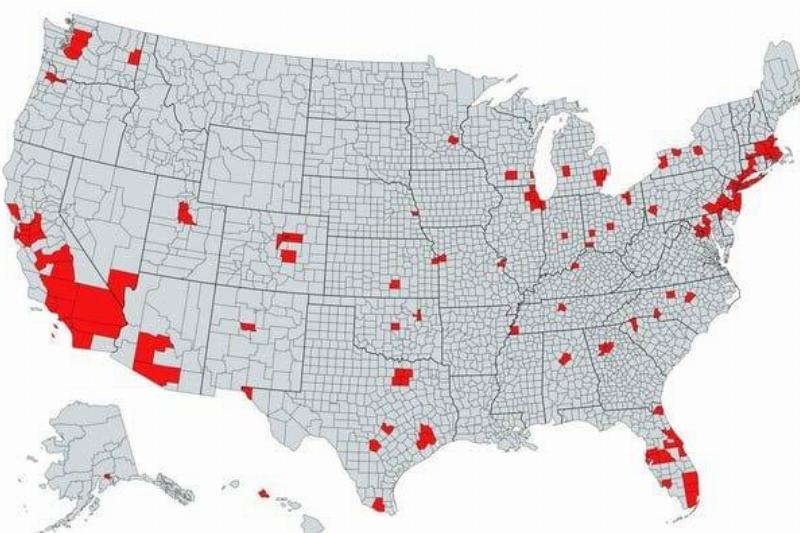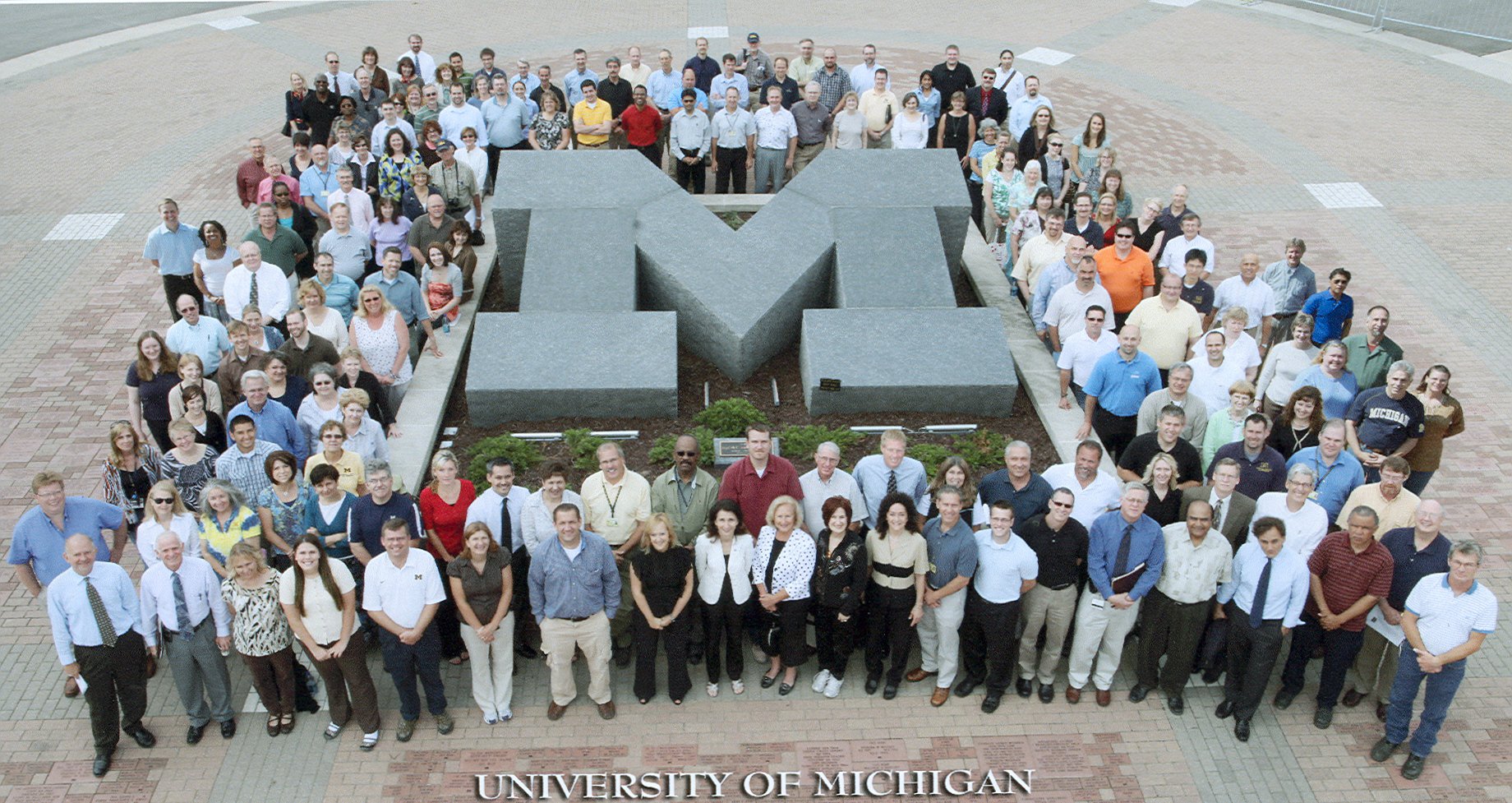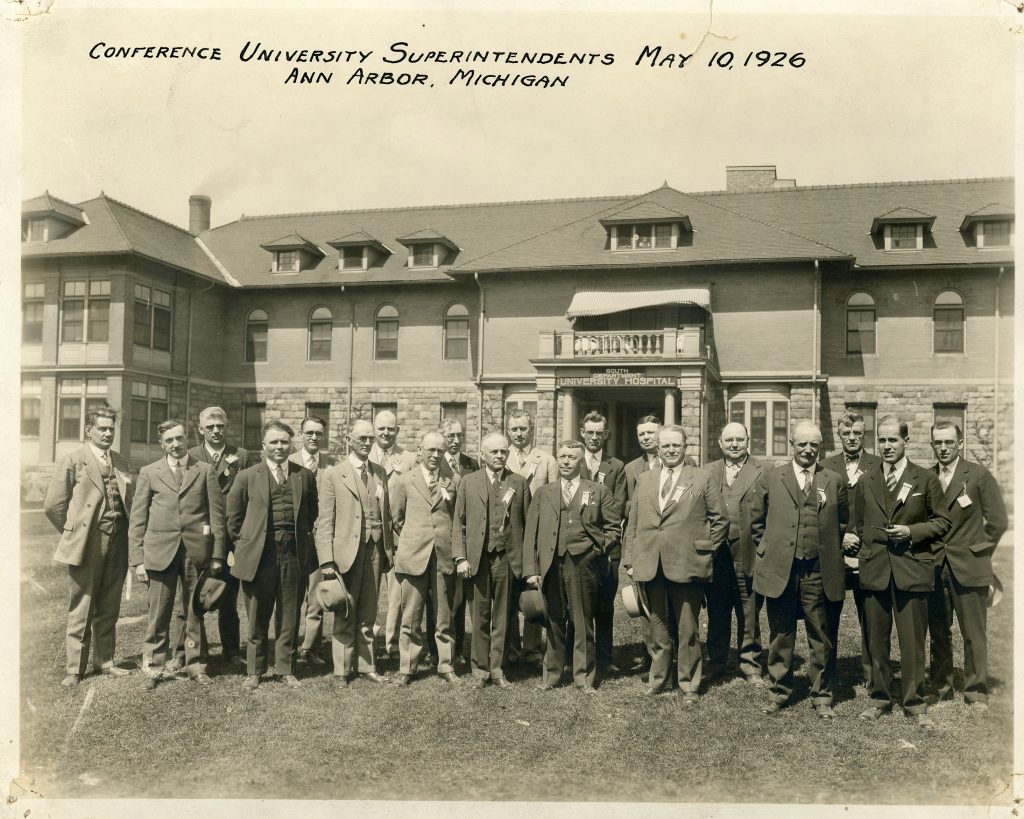Standards Michigan Group, LLC
Safer | Simpler | Lower-Cost | Longer-Lasting
“The most effective kind of education is that a child
should play amongst lovely things.”
– Plato
This history is an outgrowth of an enterprise begun at the University of Michigan in 1993 that focused on making education facilities safer, simpler, lower-cost and longer-lasting by participating assertively in ANSI-accredited, consortium and open source standards development. By assertively we mean bringing new ideas to the meeting; not simply voting Yea or Nay on the ideas of others. Given a community of over 90,000 students and staff, 36 million square feet, three campuses with a footprint of 6 square miles, and several hundred buildings for nearly every occupancy type that operated on dry land, the University of Michigan Ann Arbor settlement proved the perfect study unit for an approach that would benefit the US education industry as a whole.
If you think an undertaking like this is the proper work of one or more of the several hundred non-profit organizations servicing the United States education industry; think again. By slow degrees, after nearly a decade of shouting from the mountaintops that real asset managers in the largest non-residential building construction market in the United States needed to be at the standards development tables if it wanted to continue claiming it was doing everything to lower cost, it became obvious that none of them were interested in sustaining User-interest advocacy in consensus product* development in any meaningful way. Non-profit, membership organization business models are limited in their capacity for sustaining volunteer engagement of accomplished subject matter experts. They need membership and revenue derived from networking conferences.
Given federal and state tax incentives for building campuses higher and deeper who can blame any college or university president whose annual performance review features a box citing building construction projects. The real asset leaders that report to he or she are more interested in avoiding litigation than saving money. They also have to compete with newer economies with newer buildings early in their expense life-cycle.
Standards Michigan Net Lifetime Productivity
We send our children away to college
and they never return home the same.
They never return the same because of the people;
not the buildings
A look at the roster of conference sponsors will reveal that these trade associations derive significant revenue from corporate sponsorship. Nothing necessarily wrong with that until you find the same corporate sponsors voting against the user interest in the development of leading catalogs. Competitor stakeholders in the US standards system are able to finance their advocacy from the profit margins of the products and services they sell to education communities. Risk-adjusted, the width of those profit margins are determined by how standards are written, interpreted and enforced. We can provide 100’s of examples.
Some social institutions rely more heavily on the character of its built environment. In public construction markets “It’s everyone’s money”. Cost goes up and hardly anyone knows what to do to stop it. However, you cannot put a price tag on the culture of any nation or locality if the cost of sustaining that culture is, well, integrated into the culture itself.
Academic settlements are very territorial and a natural home for obscurity. Only in these settlements can a half-trillion dollars of annual spend be obscure.[3] Still, we stand as activists — and apologists — for the private standards system.

County map of the United States: RED features a population greater than the GRAY. The 3rd largest economy in the world according to Gross Domestic Product is the (largely food, energy and manufacturing) counties shown in gray where we find the largest non-residential building construction market. Standards Michigan continues roll out of its state-level collaboration architectures. See @StandardsState
There are no business models that solve
the wicked problem of participatory democracy.
To a large degree government regulation of any industry is just another form of market-making. Our logo — two black columns for the strongest stakeholders and one gray column for the weakest — was designed to reflect the weakness of the final fiduciary (consumer interest) in the private standards system in every nation. This weakness is a problem everywhere; though to be fair — the consumer expresses an opinion through normal market price signals. Philanthropists are inured to cost since their objective is to purchase a legacy in any of the most expensive “memorial gardens” anywhere; leaving life-cycle cost an open-ended consideration.
Long before practical energy conservation became the branded sustainability zietgeist we know today, the decision was made to advocate the University of Michigan agenda for facility construction, operation and maintenance; thereby setting an example for other asset management executives at other educational institutions in the other 49 United States. (New construction spend at the University of Michigan was running at a clip of $500 million to $1 billion annually; a spend rate fairly common among US research universities). If you want to prove the claim that you are the “Leaders and the Best” then you have to withstand the risk of being too early to the zietgest. You have to risk walking alone.
It worked. It did not happen overnight but it worked. By collaborating with other like-minded individuals in colleges and universities — and incumbent stakeholders; some of whom understood the reasonableness of what we were asking — we were able to achieve possible reductions in the cost of buildings and infrastructure at the University of Michigan which are now shared possibilities for all other colleges, universities and school districts in the United States. We understood that we could not force capital discipline and cost reduction possibilities upon any educational institution — habit and organizational cultures are not to be underestimated — but those possibilities were there for the taking whereas they did not exist before the University of Michigan created them.
We take 100 percent credit for lighting a fire under education facility trade associations to work much harder for their members in the global standards system. While their business models in both the US and elsewhere coalesce around supporting labor resources (notably facility executives and mid-level department staffers most of whom have annual salaries in the range of $100,000 to $500,000 ) we have found them to be capable trendsniffers in order to execute on that business model. We also track a number of non-profits forming to advocate consumer interests in the global standards system; though they appear to be proxies for incumbent stakeholders; notably conformance interests. Welcome.
While we acknowledge the structural impediments that prohibit the 100’s of trade associations from being wholly effective (lack of shop floor/workpoint sensibility, oversupply of red-tape-making talent; for example) we persist in applying pressure they they do so to the full extent their charter permits. We report on the activity of these non-profit associations during our Education Industry Trade Association teleconferences. See our CALENDAR for the next online meeting; open to everyone.
We’ve been at this a long time.
We estimate that the original enterprise produced 1 to 2 percent avoided cost opportunities in annual facility operating budgets by negotiating technical and policy compromises using US consensus standards system administered by the American National Standards Institute. The organization might not have taken advantage of construction cost reduction, or the opportunity to avoid re-inventing the wheel, or to avoid organizational redundancy, but those opportunities were secured for everyone. In an industry that spends nearly $500 billion annually designing, building, operating and maintaining some of the most valuable public assets, a 1 to 2 percent reduction in facility budgets should be meaningful.
Our relationships with other stakeholders have deep roots. In preserving most of the brain trust of the original enterprise, and continuing to add to our cadre of experts, we continue to provide the following:
- Education. The architectural and engineering character educational settlements support the conveyance of culture; Western culture primarily. We find that most faculty in research universities is engaged in seeking funding for their next research project. We provide support to faculty who are not exactly in the loop on the current standards action in a variety of disciplines. We support faculty who have teaching grants for standards education.
- Original research. While we are capable of large project delivery we are most effective in providing authoritative insight in smaller, faster “packages” for larger research projects for others. Supporting the research projects by others makes it possible for us to finance a website that is accurate, fast, adaptable, clean and free of clutter. Our presence on the web — here — is organized, but not too organized. Think of those rare and used bookshops West Side Book Shop here in Ann Arbor.
- Advisory and agency (due diligence) assist. Second, even third opinions on building construction design and budgets; testing. inspection, certification and commissioning.
- When you track, follow and (sometimes) front-run electrotechnology standards you necessarily keep pace with all other standards development organizations – building safety, energy, public security and the like.
- Technology and management content for education industry trade associations. Some content is free; curated content that is not in the public domain is accessible to subscribers.
- User-interest advocacy in all 50-states for said education industry trade associations. We do it at lower cost and more effectively though the process takes time.
- Cross-cutting perspective and recommendation for action on global technical and management standards relevant to the safety and sustainability objectives of the education industry. Standards are highly interlocked and cross referencing. Many technical committees are unaware what is happening elsewhere because of the sheer velocity of ideas. We have our finger on most of them; or know people who have their finger on them.
- Support for ANSI accredited standards developers who need documentation of user-interest outreach and engagement for the 5-year audit ANSI conducts for conformity to its due process requirements.
- Specific code advocacy. If a prescriptive requirement is nonsense financially we go to where the “buttons” are. We have a lengthy portfolio of success.
- A “sherpa” service to organizations whose goals align with the user-interest. ANSI’s Central Staff already does this to a large degree already but we can supplement ANSI guidance with peer-to-peer insight specific to the education facilities industry based upon where we have succeeded in the past.
- Studies and reports on standard of care and best practice as reflected in accredited standards.
- Anticipatory intelligence for strategic safety and sustainability planners.
- Accurate information about the development status of existing or new consensus products from accredited and open source standards developers.
- Faster access to network of subject matter experts in most building industry disciplines.
- Consultation and support to the legal community to fill gaps in their own understanding and status of relevant codes and standards. We do not provide expert witness services but we provide technical support for legal staff that may need the most current information.
- Despite the deep ambivalence of the US education “industry” in controlling the cost of its “settlements” [3] we persist; expecting a reckoning in the fullness of time.
Our factory settings are to respond to changes in the technical literature that informs academic territories in the United States; all the while recognizing that in such territories culture and custom comes first.
Fair Use Copyright Disclaimer § 107 Copyright Act of 1976
We are not a non-profit
We are not a blog
We are not a proxy for incumbents
We are not standards evangelizers
We are not “Oracle of Change” trendsniffers
We are not selling accessories for the “campus life”
We are not creating career tracks for “standards professionals”
We do not claim to be an opinion aggregator
We get results (that take 3 to 12 years to accomplish)
Visit us across from the University of Michigan Athletic campus
We approach best practice literature as a genre. Whenever possible we show rather than tell. We hope our selection of images provides a mirror; a way to see what others are doing. There is likely not any other industry in the United States that requires sensitivity to as many points of view.
Our field of vision encompasses the complete life cycle of consensus products that contribute to the safety and sustainability agenda of the education facility industry including product development, adoption, market recognition, utilization and adherence.
We do not hammer you with pop-ups, click-bait and cookies. More than half of the web sites with which we interact every day are so insanely “overcoded” that it is near impossible find anything actionable.
Much of our content must necessarily be protected particularly the public consultations. Our remedy is to host daily colloquia at 15:00 UTC to take hammer on proposed regulations; and updated codes and that affect the physical assets of education communities.
Use the login credentials at the upper right of our home page.
Disclaimer:
The views and opinions expressed on this blog site are those of the authors and do not reflect the official policy of the University of Michigan, a trade association or standards developer.
Retweets are not endorsements.
Corrections are gratefully received. Anyone who finds a content error will receive free access to our Premium Content for 30-days.
Statement on Protection of Standard Setting Organization Intellectual Property
[0] This number includes the public and private elementary and secondary school systems as well as colleges, universities, community colleges and private trade schools identified in IBIS World Reports. which tracks industries according to the North American Industry Classification System.
[1] The US National Technology Transfer and Advancement Act of 1995 is the parent legislation for that supports the standards setting and conformity assessment activity administered by the National Institute of Standards and Technology and the American National Standards Institute. Parts of this legislation — especially the overall intent to inspire innovation in the private sector — is found in public laws all nations; thus our attention to the education industry in all nations. For a detailed explanation of the terms Producer, General Interest and User, refer to ANSI Essential Requirements: Due Process Requirements for American national standards.
[2] We refer to the 250-odd ANSI accredited standards developers as “silos”. Keep in mind that there are hundreds of other open source and consortia standards developers that are not ANSI-accredited.
[3] Wall Street Journal: “Colleges Spend Like There’s No Tomorrow. These Places Are Just Devouring Money”
* Standards catalogs list titles that are codes, standards, guides, recommended practices which are developed by workpoint subject matter experts and administered by accrediting agencies (such as the American National Standards Institute), open-source, open-standard communities and similar consortia that can, and should supersede government action through legislation. The US Technology Transfer & Advancement Act of 1995 requires that federal agencies reference privately developed consensus products because (and, in our own parlance) the standard of care asserted in privately developed consensus products is relatively free of “market-making” by incumbent stakeholders. See Footnote [1]
**About | University of Michigan Leadership 1993 – 2016
© Standards Michigan Group, LLC | Annual Report | The Year Ahead 2025
“The object of education is to teach us to love what is beautiful.”
― Plato, The Republic pic.twitter.com/V1RnJOpk8J— 𝒩𝒶𝓉𝒶𝓁𝒾𝒶 (@classicspilled) October 27, 2025














